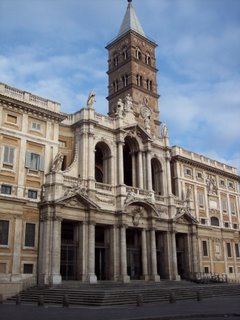 Arrived by train from Florence on the 22nd November. Cold but fortunately not raining. Found our hotel pretty easily, although we were somewhat put off by the group of young people milling around the entrance and the strong smell of dope in the entrance! The hotel was on the second floor, up a million steps again, but fortunately at this stage of the trip had a lift of sorts. We stayed right near Santa Maria Maggiore, which was built on the site of a Roman temple to the goddess Juno Lucina. She was a favourite of women, especially of pregnant women and those with small children. The Christian church was first founded in about 350 and hasa series of mosaics from that period, as well as the highest bell tower in Rome.
Arrived by train from Florence on the 22nd November. Cold but fortunately not raining. Found our hotel pretty easily, although we were somewhat put off by the group of young people milling around the entrance and the strong smell of dope in the entrance! The hotel was on the second floor, up a million steps again, but fortunately at this stage of the trip had a lift of sorts. We stayed right near Santa Maria Maggiore, which was built on the site of a Roman temple to the goddess Juno Lucina. She was a favourite of women, especially of pregnant women and those with small children. The Christian church was first founded in about 350 and hasa series of mosaics from that period, as well as the highest bell tower in Rome.Wandering through Rome in chilly winter weather is interesting... the kids found the city disorienting, but it's always fascinating as there's something around every corner or bend of cobblestoned roads.
On our rambles we came across the Piazza Minerva, in which this Bernini Elephant statue holds up an Egyptian obelisk from about 600BC. Ancient Rome had a temple to the Egyptian goddess Isis, and that temple had a row of obelisks which over the centuries have been spread out to sites all over the city.
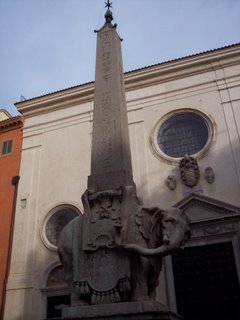 The monastery behind the church is the site where Galialeo was forced to reject his astronomical discoveries and swear, as the church commanded, that the Earth did not go around the sun.
The monastery behind the church is the site where Galialeo was forced to reject his astronomical discoveries and swear, as the church commanded, that the Earth did not go around the sun.Around the next corner is the Pantheon. It's hard to picture just how huge it is until you're standing staring up at the columns... The Pantheon was originally built as a temple to the seven deities of the seven planets in the Roman state religion. It was originally built in about 25BC during the third consulship of Marcus Vipsanius Agrips, and his name is inscribed on the portico of the building. The inscription reads M·AGRIPPA·L·F·COS·TERTIUM·FECIT, "Marcus Agrippa, son of Lucius, consul for the third time, built this." It was destroyed by fire in AD 80 and rebuilt by the Emporer Hadrian, around 125AD, and he added the inscription. It became a Christian Church in 608AD, and has been used continuously ever since. The dome is concrete and was made by piling up a huge mound of dirt, then pouring a concrete shell over the dirt. This was the largest concrete dome in the world until 1958, when a new building in Paris beat its record!
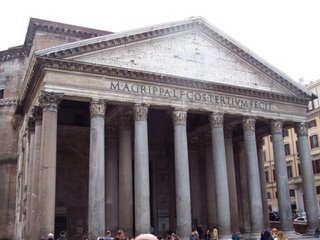 The only light to enter the building comes in through the 10m wide oculus in the centre of the dome. The original portico ceiling was lined with bronze, which was stripped by Pope Urban VIII to make bombards for Castel Sant'Angelo. The height to the oculus and the diameter of the interior circle are the same (43 metres), so the whole interior would fit exactly within a cube (alternatively, the interior could house a sphere 43
The only light to enter the building comes in through the 10m wide oculus in the centre of the dome. The original portico ceiling was lined with bronze, which was stripped by Pope Urban VIII to make bombards for Castel Sant'Angelo. The height to the oculus and the diameter of the interior circle are the same (43 metres), so the whole interior would fit exactly within a cube (alternatively, the interior could house a sphere 43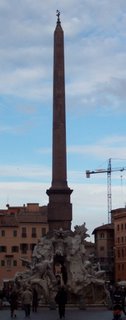 metres in diameter). The dome is the largest surviving from antiquity and was the largest dome in western Europe until Brunelleschi's dome of the Duomo of Florence was completed in 1436. The design of the Pantheon was the inspiration for the State Library of Victoria, in Melbourne.
metres in diameter). The dome is the largest surviving from antiquity and was the largest dome in western Europe until Brunelleschi's dome of the Duomo of Florence was completed in 1436. The design of the Pantheon was the inspiration for the State Library of Victoria, in Melbourne.Further on to Piazza Navone, which follows the plan of an acient Roman circus, in which mock sea battles and games were played. The fountain is another of Bernini's works: the Fountain of the Four Rivers. Sitting on the rocks, the giants symbolise the rivers of the four continents - the Danube, the Gangesm the Nile, and the Rio de la Plata, the four corners of the earth, with another obelisk on top.
Now around to the Roman Forum. This has been called the busiest deserted place in the world. In winter there aren't too many people - in summer it's very crowded and hot. The water in all the fountains is, however, very drinkable. The church behind this statue is Santa Luca e Martina, and was built in the 6th or 7th century.
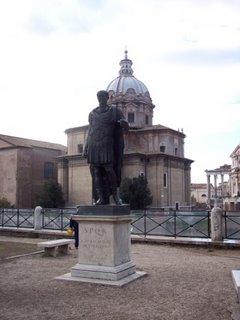 It was rebuilt with the dome in the 1600s, and stands where the Forum Romanun meets the Forum Augustus and the Forum Cesar. SPQR is everywhere in Rome, and represents the latin phrase Senatus Populusque Romani, or "The Senate and People of Rome" (alternatively, according to Obelisk, it stands for "Sono pazzi questi Romani", which translates into "These Romans are crazy !!) Don't get too excited when you see it on manhole covers etc though, it was put onto them by Mussolini an was used as propoganda for his regime.
It was rebuilt with the dome in the 1600s, and stands where the Forum Romanun meets the Forum Augustus and the Forum Cesar. SPQR is everywhere in Rome, and represents the latin phrase Senatus Populusque Romani, or "The Senate and People of Rome" (alternatively, according to Obelisk, it stands for "Sono pazzi questi Romani", which translates into "These Romans are crazy !!) Don't get too excited when you see it on manhole covers etc though, it was put onto them by Mussolini an was used as propoganda for his regime.On the left is the Forum Romanum - the Roman Forum. It takes a little while to get oriented and realise just how amazing it is to be able to actually stand here and look over this archaelogical site.
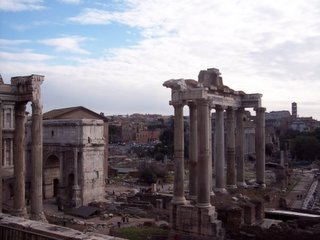 On the far left you can see the arch of Septimus Severus. This is a triumphal arch, erected in 203 AD to celebrate the victories of the Emporer Septimus Severus and his sons Caracella and Geta in te wars against the Parthians and the Osroeni in 195 and 197 AD. It spans the Via Sacra on the route of triumphal processions just before the ascent of the Capitoline Hill. To get an idea of the depth of excavations, the road was just below the top of the arch. The colums on the right were the Temple of Saturn. In the other photo below, more of the Forum is visible.
On the far left you can see the arch of Septimus Severus. This is a triumphal arch, erected in 203 AD to celebrate the victories of the Emporer Septimus Severus and his sons Caracella and Geta in te wars against the Parthians and the Osroeni in 195 and 197 AD. It spans the Via Sacra on the route of triumphal processions just before the ascent of the Capitoline Hill. To get an idea of the depth of excavations, the road was just below the top of the arch. The colums on the right were the Temple of Saturn. In the other photo below, more of the Forum is visible.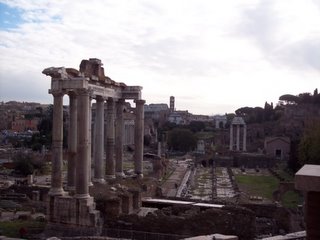 The three columns are the Temple of Castor and Pollux, and just behind this to the left is the remains of the House of the Vestal Virgins. Lots of other things to be seen here, but too many for a blog! In the background, of course, is the Colosseum..
The three columns are the Temple of Castor and Pollux, and just behind this to the left is the remains of the House of the Vestal Virgins. Lots of other things to be seen here, but too many for a blog! In the background, of course, is the Colosseum..Last thing along the Via Sacra before the Colosseum is
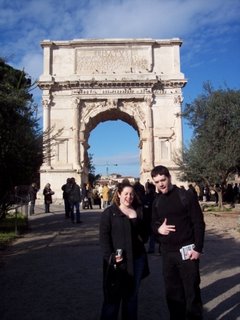 the Arch of Titus, built by the Senate after the Emporer's death to commemorate his conquest of Jerusalem in 70AD. Don't be too tempted to step over the chains and have your photo taken under the arch though... the last person to march under it was Hitler, and it's closed off to some extent as a mark of respect to Jews worldwide...
the Arch of Titus, built by the Senate after the Emporer's death to commemorate his conquest of Jerusalem in 70AD. Don't be too tempted to step over the chains and have your photo taken under the arch though... the last person to march under it was Hitler, and it's closed off to some extent as a mark of respect to Jews worldwide... Outside the Colosseum.. obviosuly waiting for next chariot race!! Dontcha love the one with the fag in his mouth!
Outside the Colosseum.. obviosuly waiting for next chariot race!! Dontcha love the one with the fag in his mouth!Lastly the Colosseum. The Colosseum was originally known as the Flavian Amphitheatre, and was capable in its day of seating 50000 spectators. Construction was started by Emporer Vespasian and completed by his sons Titus and Domitian between AD 72 and AD 81. It was built at the site of Nero's palace, the Domus Aurea, and derives the name Colosseum from a colossus - a 40m statue of Nero which once stood nearby. In the 100 days of celebration to inaugurate the opening of the amphitheatre, some 9,000 wild animals were killed. The arena floor was covered with sand, presumably to allow the blood to drain away. The Colosseum hosted large-scale spectacular games that included fights between animals, the killing of prisoners by animals and other executions, naval battles (via flooding the arena) up until AD 81, and combats between gladiators . It has been estimated that several hundreds of thousands died in the Colosseum games.
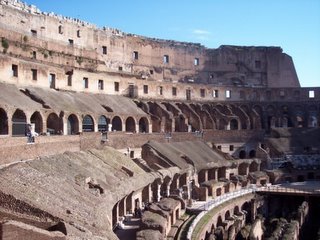
Seating was divided into different sections. The podium, the first level of seating, was for the Roman senators; the emperor's private, cushioned, marble box was also located on this level. Above the podium was the maenianum primum, for the other Roman aristocrats who were not in the senate. The third level, the maenianum secundum, was divided into three sections. The lower part was for wealthy citizens, while the upper part was for poor citizens. A third, wooden section was a wooden structure at the very top of the building, added by Domitian. It was standing room only, and was for lower-class women.
After the Colosseum's first two years in operation, Vespasian's younger son (the newly-designated Emperor Domitian) ordered the construction of the hypogeum (literally meaning "underground"), a two-level subterranean network of tunnels and cages where gladiators and animals were held before contests began. Numerous trap doors in the floor provided instant access to the arena for caged animals and scenery pieces concealed underneath; larger hinged platforms provided access for elephants and the like.
Today the arena floor no longer exists, though the hypogeum walls and corridors are clearly visible in the ruins of the structure. The entire base of the Colosseum covers an area equivalent to 6 acres. There are also tunnels, still in existence, configured to flood and evacuate water from the Colosseum floor, so that naval battles could be staged prior to the hypogeum's construction.
No comments:
Post a Comment